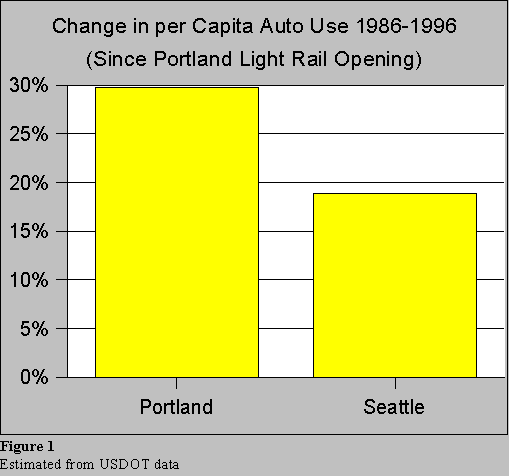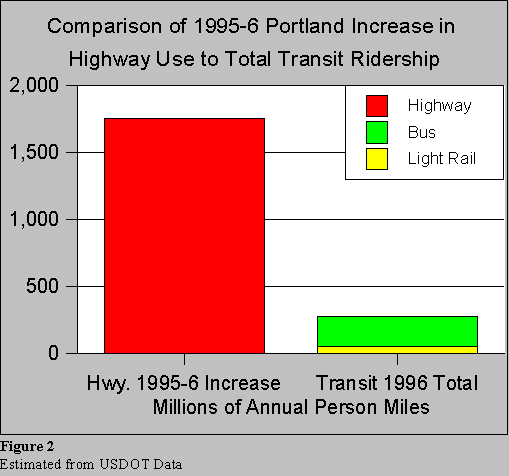A freeway lane carries
3 to 5 times the person-miles of
a light rail system .
The organizations of reference: http://www.cfte.org/responding/respond_critics.htm
|
More than 20 years ago
Portland Oregon encouraged
more dense urban development,
to stop the “evil urban sprawl”.
They built a light rail line
(in contrast to Seattle, Washington)
the facts
portray a failure. |
Portland Trends Compared to Seattle
http://www.publicpurpose.com/dmseapor.htm
| Daily Work Trips by Passenger
Transport |
| |
Seattle
|
Portland
|
|
1980
|
79,323
|
47,504
|
|
1990
|
82,619
|
39,259
|
|
Change
|
3,296
|
(8,245)
|
|
%Change
|
4.2%
|
-17.4%
|
|
 |
The latest data released by the Texas Transportation Institute
indicates that street and highway use per capita continues to rise rapidly
in Portland, despite new urbanist planning
policies intended to reduce automobile dependency.
From 1986 (the year before Portland's light rail line opened) to 1996,
average auto passenger miles per capita in the Portland urbanized area increased
29.8 percent. This compares to an 18.9 percent increase in Seattle, which
had neither light rail nor new urbanist planning policies.
Portland
2000
And now, early 2000 census data indicates that at least one urban area –
Portland, the international paragon of light rail – has seen its transit work trip market share rise from a dismal 6.3
percent to a nearly as dismal 7.4 percent over the last decade.
Other light rail cities have done less well, with market
share losses of up to the 35 percent of St.
Louis. http://www.tppf.org/veritas/vol3_issue2/wendellcox.pdf
|
A recent Orange County, California grand jury report noted:
A test of light rail's success is not how many people are on the trains; it is
how many cars light rail has removed from the road, especially during peak
hours.
Despite ridership increases in the "Does Transit
Work?" case studies of Chicago (commuter rail only) and San Diego, work trip market share dropped between 1980
and 1990.
St. Louis light rail http://www.tppf.org/veritas/vol3_issue2/wendellcox.pdf
The $400 million St. Louis light rail line, considered by many to be the most
successful new line in the nation, has had virtually no impact on adjacent
freeway traffic volumes.
Here are the St Louis FACTS
 |
The increase in private vehicle usage
was particularly strong from 1995 to 1996, annual person miles traveled by
private vehicle increased approximately 1.75 billion, to more than 15
billion annual person miles.
By comparison, total transit passenger miles were 272 million. The increase in private vehicle use was more than 35
times the total light rail usage and more than six times total transit
usage.
Further, the average route mile of the light rail system carries
substantially fewer person miles than either a freeway lane or a surface
arterial lane (city street).
Light rail carries an estimated 10,600 person miles daily per route mile.
The average Portland Freeway Lane carries nearly
five times as many Light Rail person miles, at
54,700.
The average Portland surface arterial lane carries more than twice as many
person miles, at 21,300.
http://www.publicpurpose.com/ut-porhwy96.htm
|
|
